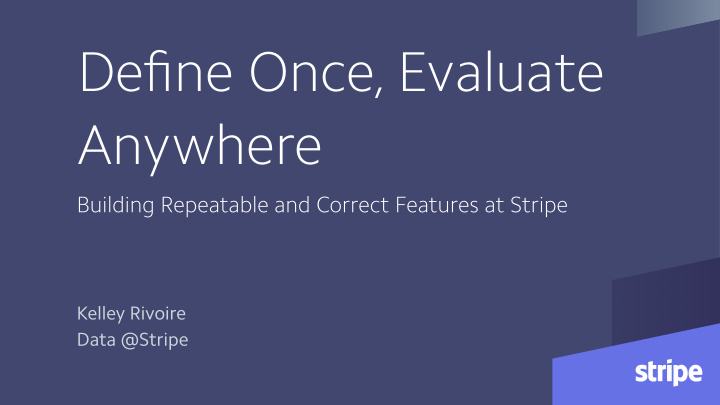



Define Once, Evaluate Anywhere Building Repeatable and Correct Features at Stripe Kelley Rivoire Data @Stripe
Outline • ML at Stripe! • The reality of features • Our approach • How we run it
Stripe
Real World ML (@Stripe) • Stripe provides a toolkit to start and run an internet business • Need to make decisions quickly and at scale. • Our actions a ff ect real businesses.
Improving our operations
A fiction about ML We have a beautiful table of data: a tall matrix that represents Ground Truth about Reality.
A fiction about ML
Reality F eature engineering: turn a giant pile of serialized data into a sane matrix to feed to a training algorithm.
Key challenges • There are many di ff erent data stores and event streams. How do we integrate them? • How to produce a historical view of state when a prediction would have been made ? Time-aware joins are easy to get wrong. • How to prevent “label leakage” with labels leaking into training data? • How to make sure data for training is consistent with data for scoring ? • How to share code to generate data for training and scoring?
Training on future data Feature idea: fraud rate by e-mail! Compute fraud rates Both charges disputed as fraud!! kelley@stripe.com makes a charge on business B kelley@stripe.com makes a charge on business A
Features are used in rules, too!
Features and events
The input matrix to models are Features attached to Events • At an event, we can lookup a feature value (which exists at all times) • With the event and the feature we can either train or evaluate We require all data inputs to be evented data.
Core types: Event, Feature Events are things that pop out of Ka fl a! Features are about a subject of type K. We can partition updates to feature by the K, e.g. K=user, merchant, tweetid, contentid, etc...
Feature.map creates new columns from old • E.g. from Feature[Merchant, (TotalChargeCount, TotalChargeAmount)] we can use .map to get average charge amount.
Event.lookup reads Features
Event.lookup reads Features When generating training data, it is critical that the events see the value of the feature as it was at the event’s time . • very tedious to do by hand. • keeping this declarative the system can manage these lookups correctly. • Call this “temporal consistency”
Example features
But how do you actually run it? • Once we have the AST, we have several backends that can evaluate a feature, either a total history or evaluate at a point in time, given the Event source • E.g. interpreter, map/reduce-like backend, push-based realtime backend
Map/reduce-like backend
Do you use it? • Yes! We use this to generate, e.g., features that score our fraud models • The most complex graphs have around 1400 feature/event nodes. • We can update features for very complex feature graphs in around 60ms p99 which can involve updating more than 100 keys.
How does it fit together?
Summary • This system gives a minimal and principled API for feature engineers. • The principled nature means the backend system has a lot of power to optimize or run in di ff erent environments (easy to change how we compute, without changing what we compute). • Solves the problem of separating business logic completely from the implementation details. • Frees the feature engineer from having to worry about temporal consistency.
Come work with me! • Stripe is hiring for a lot of interesting data and ML roles! • We use data technology to track and move money. • We are building state-of-the-art ML infrastructure for feature engineering, model training and evaluation.
Thanks! Special thanks to Oscar Boykin, Erik Osheim, Sam Ritchie, Travis Brown Machine Learning Infrastructure @Stripe
Recommend
More recommend